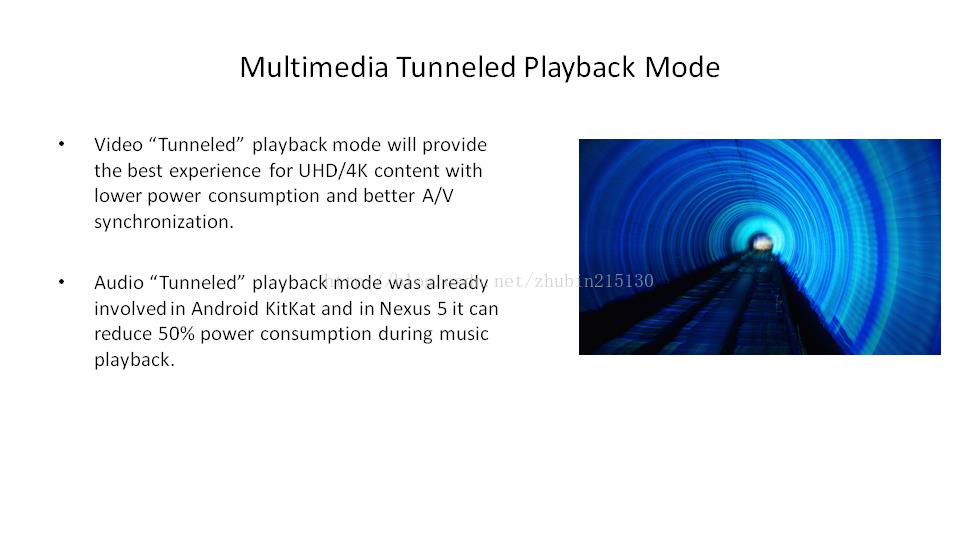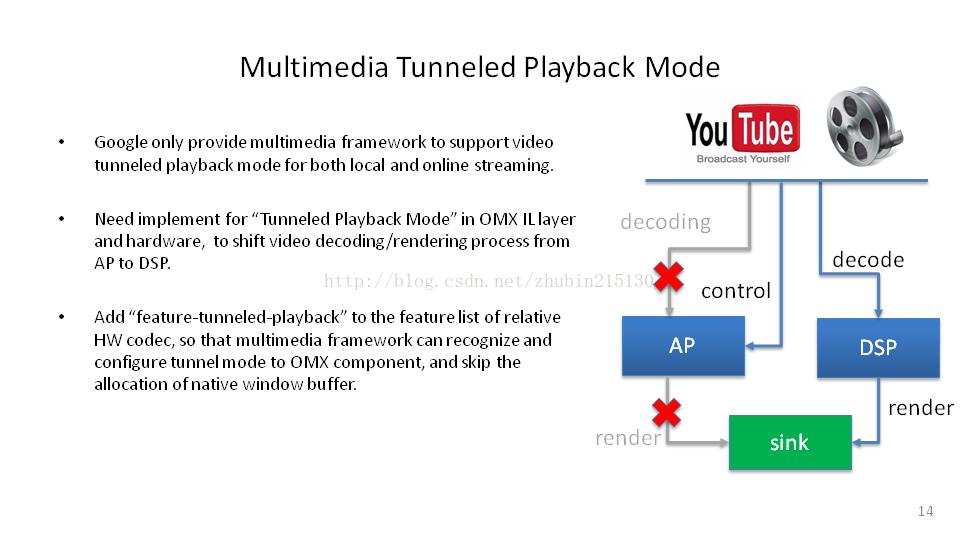深入理解Android Tunnel Mode
Posted zhanghui_cuc
tags:
篇首语:本文由小常识网(cha138.com)小编为大家整理,主要介绍了深入理解Android Tunnel Mode相关的知识,希望对你有一定的参考价值。
什么是Tunnel mode?
通俗的说就是video的offload playback mode,把视频解码\\音画同步\\渲染的工作从由AP(Application Processor)完成转变为都由DSP来完成,甚至全程不需要android Framework的参与,性能更强、功耗更低,尤其适合在TV设备上播放UHD\\HDR\\高码率\\高帧率内容。

Audio的Tunnel mode在kitkat中就已经存在了,可以在音乐播放中起到节省电量的作用。
Google为本地和在线播放的Tunnel mode提供了framework,但是需要在OMX IL层的硬件层做具体的实现,将视频decode和render的工作从AP转移到DSP。
这里面包括给相关硬件解码器的feature list加上”feature tunnel playback”项,从而让multimedia framework能够为OMX components识别\\配置tunnel mode,再略过原本在多媒体framework中需要进行的native window buffer分配等工作来进行渲染。

MediaCodec中的Tunnel Mode
MediaCodecInfo.CodecCapabilities中与Tunnel playback有关的内容
/**
* <b>video or audio decoder only</b>: codec supports tunneled playback.
*/
public static final String FEATURE_TunneledPlayback = "tunneled-playback";
Exoplayer中用DecoderInfo封装了MediaCodecInfo.CodecCapabilities,在com/google/android/exoplayer/MediaCodecTrackRenderer.java的maybeInitCodec函数中获取DecoderInfo信息
//获取解码器信息
DecoderInfo decoderInfo = null;
try
decoderInfo = getDecoderInfo(mediaCodecSelector, mimeType, requiresSecureDecoder);
catch (DecoderQueryException e)
notifyAndThrowDecoderInitError(new DecoderInitializationException(format, e,
requiresSecureDecoder, DecoderInitializationException.DECODER_QUERY_ERROR));
此外,我们也可以直接用下面的代码查看全部Codec对tunneled-playback feature的支持
int numCodecs = MediaCodecList.getCodecCount();
for (int i = 0; i < numCodecs; i++)
MediaCodecInfo codecInfo = MediaCodecList.getCodecInfoAt(i);
String name = codecInfo.getName();
Log.i(TAG, "Examinig " + (codecInfo.isEncoder() ? "encoder" : "decoder") + ": " + name);
for(String type: codecInfo.getSupportedTypes())
boolean tp = codecInfo.getCapabilitiesForType(type).isFeatureSupported(MediaCodecInfo.CodecCapabilities.FEATURE_TunneledPlayback);
Log.i(TAG, "supports tunneled playback: " + tp);
codec的feature可以直接在media_codecs.xml中看到,举例
<MediaCodec name="OMX.qcom.video.decoder.avc" type="video/avc">
<Quirk name="requires-allocate-on-input-ports"/>
<Quirk name="requires-allocate-on-output-ports"/>
<Limit name="size" min="64x64" max="4096x2160"/>
<Limit name="alignment" value="2x2"/>
<Limit name="block-size" value="16x16"/>
<Limit name="blocks-per-second" min="1" max="1958400"/>
<Limit name="bitrate" range="1-100000000"/>
<Limit name="frame-rate" range="1-240"/>
<Limit name="vt-low-latency" value="1"/>
<Limit name="vt-max-macroblock-processing-rate" value="972000"/>
<Limit name="vt-max-level" value="52"/>
<Limit name="vt-max-instances" value="16"/>
<Feature name="adaptive-playback"/>
<Limit name="concurrent-instances" max="16"/>
</MediaCodec>
在MTK和高通平台的手机上查看的结果是没有任何Codec支持tunneled-playback feature,包括OMX.qcom.video.decoder.hevc等等。
但是在MSTAR、AMLOGIC等电视上则找到了支持tunneled playback的codec
<MediaCodec name="OMX.MS.AVC.Decoder" type="video/avc">
<Limit name="concurrent-instances" max="32"/>
<Quirk name="requires-allocate-on-input-ports"/>
<Quirk name="requires-allocate-on-output-ports"/>
<Quirk name="requires-loaded-to-idle-after-allocation"/>
<Limit name="size" min="64x64" max="3840x2160"/>
<Limit name="alignment" value="2x2"/>
<Limit name="block-size" value="16x16"/>
<Limit name="blocks-per-second" min="1" max="972000"/>
<Feature name="adaptive-playback"/>
<Feature name="tunneled-playback"/> 在这里
</MediaCodec>
深入到framework中看看omx层对应的实现
/frameworks/av/media/libstagefright/Acodec.cpp
status_t ACodec::configureTunneledVideoPlayback(
int32_t audioHwSync, const sp<ANativeWindow> &nativeWindow)
native_handle_t* sidebandHandle;
status_t err = mOMX->configureVideoTunnelMode(
mNode, kPortIndexOutput, OMX_TRUE, audioHwSync, &sidebandHandle);
if (err != OK)
ALOGE("configureVideoTunnelMode failed! (err %d).", err);
return err;
….....
上面的内容会去调用
status_t OMXNodeInstance::configureVideoTunnelMode(
OMX_U32 portIndex, OMX_BOOL tunneled, OMX_U32 audioHwSync,
native_handle_t **sidebandHandle)
…..
ConfigureVideoTunnelModeParams tunnelParams;
InitOMXParams(&tunnelParams);
tunnelParams.nPortIndex = portIndex;
tunnelParams.bTunneled = tunneled;
tunnelParams.nAudioHwSync = audioHwSync;
err = OMX_SetParameter(mHandle, index, &tunnelParams);
…....
err = OMX_GetParameter(mHandle, index, &tunnelParams);
…....
if (sidebandHandle)
*sidebandHandle = (native_handle_t*)tunnelParams.pSidebandWindow;
.......
/frameworks/native/include/media/hardware/HardwareAPI.h
描述VideoTunnelMode参数的结构体,被OMX_SetParameter和OMX_GetParameter调用.
bTunneled用于指明video decoder是否工作在Tunneled Mode
如果为true, video decoder将decoded frames直接输出到sink,此时nAudioHwSync对应前面所设置的KEY_SESSION_ID,即当前的视频流要和哪个音频流同步(hardware synchronizaiton).
如果为false,不工作在tunneled mode, nAudioHwSync也要被ignore
pSidebandWindow指向codec allocated sideband window
// A pointer to this struct is passed to OMX_SetParameter or OMX_GetParameter
// when the extension index for the
// 'OMX.google.android.index.configureVideoTunnelMode' extension is given.
// If the extension is supported then tunneled playback mode should be supported
// by the codec. If bTunneled is set to OMX_TRUE then the video decoder should
// operate in "tunneled" mode and output its decoded frames directly to the
// sink. In this case nAudioHwSync is the HW SYNC ID of the audio HAL Output
// stream to sync the video with. If bTunneled is set to OMX_FALSE, "tunneled"
// mode should be disabled and nAudioHwSync should be ignored.
// OMX_GetParameter is used to query tunneling configuration. bTunneled should
// return whether decoder is operating in tunneled mode, and if it is,
// pSidebandWindow should contain the codec allocated sideband window handle.
struct ConfigureVideoTunnelModeParams
OMX_U32 nSize; // IN
OMX_VERSIONTYPE nVersion; // IN
OMX_U32 nPortIndex; // IN
OMX_BOOL bTunneled; // IN/OUT
OMX_U32 nAudioHwSync; // IN
OMX_PTR pSidebandWindow; // OUT
;
......
在底层还会看到
OMX_ERRORTYPE MS_OMX_VideoDecodeGetParameter(
OMX_IN OMX_HANDLETYPE hComponent,
OMX_IN OMX_INDEXTYPE nParamIndex,
OMX_INOUT OMX_PTR ComponentParameterStructure)
…..
switch (nParamIndex)
case OMX_IndexParamConfigureVideoTunnelMode:
ConfigureVideoTunnelModeParams *tunnelParams = (ConfigureVideoTunnelModeParams *)ComponentParameterStructure;
if (tunnelParams->nPortIndex != OUTPUT_PORT_INDEX)
ret = OMX_ErrorBadPortIndex; //看这里
goto EXIT;
MS_VDEC_HANDLE *handle = (MS_VDEC_HANDLE *)pMSComponent->hCodecHandle;
tunnelParams->bTunneled = handle->bSideBand;
tunnelParams->pSidebandWindow = handle->pSidebandWindow;
break;
…..
显示通路中的Tunnel Mode
先说ACodec,如果OMX组件支持tunneled的话,ACodec会skip the allocation of output buffer from the native window
status_t ACodec::configureOutputBuffersFromNativeWindow(
OMX_U32 *bufferCount, OMX_U32 *bufferSize,
OMX_U32 *minUndequeuedBuffers) …...
// Exits here for tunneled video playback codecs -- i.e. skips native window
// buffer allocation step as this is managed by the tunneled OMX omponent
// itself and explicitly sets def.nBufferCountActual to 0.
if (mTunneled)
ALOGV("Tunneled Playback: skipping native window buffer allocation.");
def.nBufferCountActual = 0;
err = mOMX->setParameter(
mNode, OMX_IndexParamPortDefinition, &def, sizeof(def));
*minUndequeuedBuffers = 0;
*bufferCount = 0;
*bufferSize = 0;
return err;
…...
在Tunnel Mode中有一个关键概念Sideband stream。
在/frameworks/native/services/surfaceflinger/DisplayHardware/HWComposer.cpp我们可以看到
virtual void setSidebandStream(const sp<NativeHandle>& stream)
ALOG_ASSERT(stream->handle() != NULL);
getLayer()->compositionType = HWC_SIDEBAND;
getLayer()->sidebandStream = stream->handle();
HWC_SIDEBAND的定义在
/hardware/libhardware/include/hardware/hwcomposer_defs.h
/* this layer's contents are taken from a sideband buffer stream.
* Added in HWC_DEVICE_API_VERSION_1_4. */
HWC_SIDEBAND = 4,
compositionType和getLayer()->sidebandStream的定义在/hardware/libhardware/include/hardware/hwcomposer.h
如何显示?如果指定了HWC_SIDEBAND,不由Layer处理显示
In /frameworks/native/services/surfaceflinger/SurfaceFlinger.cpp
bool SurfaceFlinger::doComposeSurfaces(const sp<const DisplayDevice>& hw, const Region& dirty)......
/*and then, render the layers targeted at the framebuffer*/
switch (cur->getCompositionType())
case HWC_CURSOR_OVERLAY:case HWC_OVERLAY:
const Layer::State& state(layer->getDrawingState());
if ((cur->getHints() & HWC_HINT_CLEAR_FB)
&& I && layer->isOpaque(state) && (state.alpha == 0xFF)
&& hasGlesComposition)
// never clear the very first layer since we're
// guaranteed the FB is already cleared
layer->clearWithOpenGL(hw, clip);
break;
case HWC_FRAMEBUFFER(代表常规的显示方法):
layer->draw(hw, clip);
Break;
......
总结重点如下:
- OMX组件需要有支持tunnel playback的标识
- Tunnel Mode下的音画同步由硬件完成
- Tunnel Mode解码器直接将解码后的数据吐给显示硬件,走sideband stream
- Tunnel Mode下的解码、音画同步和渲染完全由芯片厂商自定义,全程无需Android Framework层的参与
怎么用Tunnel Mode
参考cts中的实现
cts/tests/tests/media/src/android/media/cts/MediaCodecTunneledPlayer.java
// setup tunneled video codec if needed
if (isVideo && mTunneled)
format.setFeatureEnabled(MediaCodecInfo.CodecCapabilities.FEATURE_TunneledPlayback,
true);
MediaCodecList mcl = new MediaCodecList(MediaCodecList.ALL_CODECS);
String codecName = mcl.findDecoderForFormat(format);
if (codecName == null)
Log.e(TAG,"addTrack - Could not find Tunneled playback codec for "+mime+
" format!");
return false;
codec = MediaCodec.createByCodecName(codecName);
if (codec == null)
Log.e(TAG, "addTrack - Could not create Tunneled playback codec "+
codecName+"!");
return false;
if (mAudioTrackState != null)
format.setInteger(MediaFormat.KEY_AUDIO_SESSION_ID, mAudiosessionId);
/cts/tests/tests/media/src/android/media/cts/CodecState.java
public void start()
mCodec.start();
mCodecInputBuffers = mCodec.getInputBuffers();
if (!mTunneled || mIsAudio)
mCodecOutputBuffers = mCodec.getOutputBuffers();
.....
public void flush()
mAvailableInputBufferIndices.clear();
if (!mTunneled || mIsAudio)
mAvailableOutputBufferIndices.clear();
mAvailableOutputBufferInfos.clear();
....
mCodec.flush();
......
public void doSomeWork()
......
while (feedInputBuffer())
if (mIsAudio || !mTunneled)
MediaCodec.BufferInfo info = new MediaCodec.BufferInfo();
int indexOutput = mCodec.dequeueOutputBuffer(info, 0 /* timeoutUs */);
if (indexOutput == MediaCodec.INFO_OUTPUT_FORMAT_CHANGED)
mOutputFormat = mCodec.getOutputFormat();
onOutputFormatChanged();
else if (indexOutput == MediaCodec.INFO_OUTPUT_BUFFERS_CHANGED)
mCodecOutputBuffers = mCodec.getOutputBuffers();
else if (indexOutput != MediaCodec.INFO_TRY_AGAIN_LATER)
mAvailableOutputBufferIndices.add(indexOutput);
mAvailableOutputBufferInfos.add(info);
.......
.......
private boolean feedInputBuffer() throws MediaCodec.CryptoException, IllegalStateException
......
if (mTunneled && !mIsAudio)
if (mSampleBaseTimeUs == -1)
mSampleBaseTimeUs = sampleTime;
sampleTime -= mSampleBaseTimeUs;
// FIX-ME: in tunneled mode we currently use input buffer time
// as video presentation time. This is not accurate and should be fixed
mPresentationTimeUs = sampleTime;
......
}
/cts/tests/tests/media/src/android/media/cts/DecoderTest.java
/**
* Test tunneled video playback mode if supported
*/
public void testTunneledVideoPlayback() throws Exception
if (!isVideoFeatureSupported(MediaFormat.MIMETYPE_VIDEO_AVC,
CodecCapabilities.FEATURE_TunneledPlayback